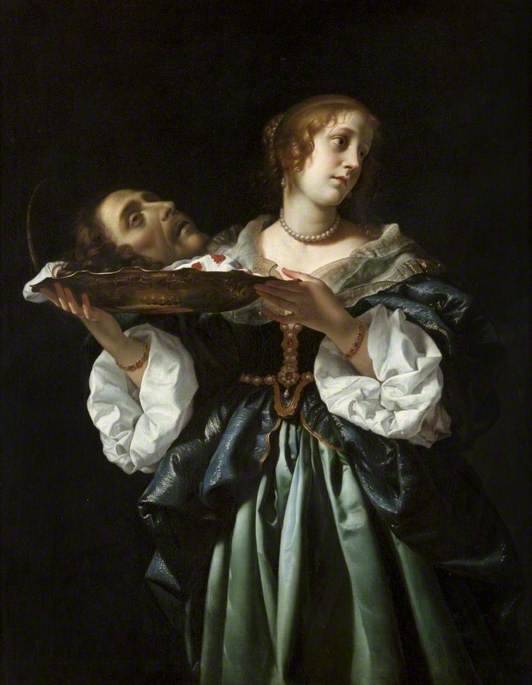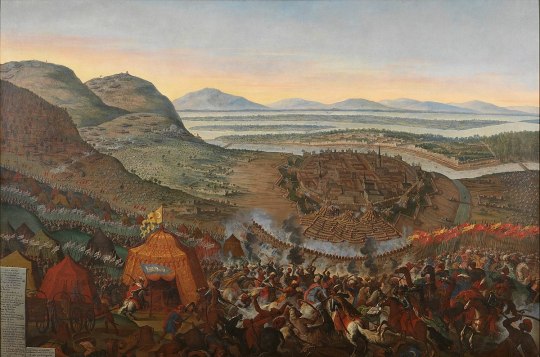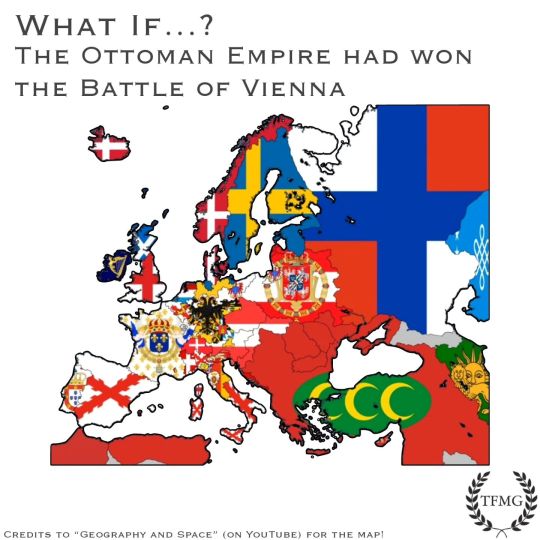#1683
Text

44 notes
·
View notes
Photo

The Greatest Extent of Ottoman Empire
127 notes
·
View notes
Photo

Salome, Carlo Dolci, 1681-85
#salome#Salome with the head of John the baptist#Carlo dolci#dolci#1681#1682#1683#1684#1685#1680s#1600s#17th century#painting#art#baroque
100 notes
·
View notes
Photo

Frans Geffels - The relief of Vienna in 1683 - 1683-4
oil on canvas, height: 184 cm (72.4 in); width: 272 cm (107 in)
Vienna Museum at Karlsplatz, Austria
The Battle of Vienna took place at Kahlenberg Mountain near Vienna on 12 September 1683 after the imperial city had been besieged by the Ottoman Empire for two months. The battle was fought by the Holy Roman Empire (led by the Habsburg monarchy and the Polish–Lithuanian Commonwealth, both under the command of King John III Sobieski) against the Ottomans and their vassal and tributary states. The battle marked the first time the Commonwealth and the Holy Roman Empire had cooperated militarily against the Ottomans, and it is often seen as a turning point in history, after which "the Ottoman Turks ceased to be a menace to the Christian world". In the ensuing war that lasted until 1699, the Ottomans lost almost all of Hungary to the Holy Roman Emperor Leopold I.
The battle was won by the combined forces of the Holy Roman Empire and the Polish–Lithuanian Commonwealth, the latter represented only by the forces of the Crown of the Kingdom of Poland (the march of the Lithuanian army was delayed, and they reached Vienna after it had been relieved). The Viennese garrison was led by Feldzeugmeister of the Imperial Army (Holy Roman Empire) Ernst Rüdiger Graf von Starhemberg, an Austrian subject of Holy Roman Emperor Leopold I. The overall command was held by the senior leader, the king of Poland, John III Sobieski, who led the relief forces.
The opposing military forces were those of the Ottoman Empire and its vassal states, commanded by Grand Vizier Merzifonlu Kara Mustafa Pasha. The Ottoman army numbered approximately 90,000 to 300,000 men (according to documents on the order of battle found in Kara Mustafa's tent, initial strength at the start of the campaign was 170,000 men). They began the siege on 14 July 1683. Ottoman forces consisted, among other units, of 60 ortas of Janissaries (12,000 men paper-strength) with an observation army of some 70,000 men watching the countryside. The decisive battle took place on 12 September, after the arrival of the united relief army.
Historians maintain that the battle marked the turning point in the Ottoman–Habsburg wars, a 300-year struggle between the Holy Roman and Ottoman Empires. During the 16 years following the battle, the Austrian Habsburgs gradually recovered and dominated southern Hungary and Transylvania, which was largely cleared of Ottoman forces. The battle is noted for including the largest known cavalry charge in history.
Frans Geffels, known in Italy as Francesco Geffels (25 August 1624 – 18 February 1694) was a Flemish painter, printmaker, architect, stage designer and designer of ephemeral structures for solemn and festive occasions. After training in his native Antwerp, he was mainly active in Mantua, where he was prefetto delle fabbriche to the Duke, a role that gave him the direction of the artistic and construction activities undertaken by the Ducal court. He worked also on projects for the local aristocratic class of Mantua. In addition, he completed projects for the Liechtenstein princes and for the imperial court in Vienna.
He was both a canvas and fresco painter. He created portraits, history subjects, military scenes, architectural scenes and genre art, in particular merry companies. Geffels is mainly remembered as the designer of some of the key examples of Baroque architecture in Mantua.
21 notes
·
View notes
Photo

Carlos II ante la Sagrada Forma
by Pedro Ruiz González (Toledan, 1640 – 1706)
oil on canvas (166,2 × 232,1 cm), 1683
Museo de Arte de Ponce
November 29th marks, in the Hispanic world, the Feast of the Most Blessed Sacrament, also known as the Little Corpus (”Corpus Chiquito” or “Corpus Pequeño”). It was one of two main Catholic festivities in November alongside the Feast of the Patronage of the Virgin, which was celebrated each second Sunday of the month.
#702304402271272960/1nbZUjrA#Pedro Ruiz González#Architecture#Catholic Church#House of Habsburg#Blessed Sacrament#Charles II of Spain#Monarquía Hispánica#Spain#17th century#1683#Baroque#Museo de Arte de Ponce#sacred art#oil on canvas#paintings
27 notes
·
View notes
Text

White Rabbit, Wave and Full Moon, Kano Tsunenobu, c.1683.
10 notes
·
View notes
Link
Check out this listing I just added to my Poshmark closet: Vintage Calvin Klein blue Necktie.
0 notes
Text
What was the most important Latin cipher of the middle ages?
0 notes
Text
Winged Hussars
Mais Vienne est à un carrefour d'histoire. Autour d'elle
retentissent des chocs d'empires. Certains soirs où le ciel se
couvre de sang, les cheavaux de pierre, sur les monuments du
Ring, semblent s'envoler. Dans cet instant fugitif, où tout
parle de puissance et d'histoire, on peut distinctement entendre,
sous la ruée des escadrons polonais, la chute fracassante du
royaume ottoman. Cela non plus fait pas assez de silence.
0 notes
Text
339 Years Ago Today: Controversy between lord Baltimore and William Penn. Lord Baltimore appointed Col. Talbot to demand of Penn all the lands lying on the west side of the river Delaware and south of the 40th degree, as a part of Maryland. #history #thisdayinhistory
SEPTEMBER 17, 1683
Controversy between lord Baltimore and William Penn. Lord Baltimore appointed Col. Talbot to demand of Penn all the lands lying on the west side of the river Delaware and south of the 40th degree, as a part of Maryland.
SOURCE: The Every Day Book of History and Chronology by Joel Munsell (gutenberg.org)
Thanks for visting!

View On WordPress
0 notes
Photo

Missing my Bunz-warmer. 2022 Daily drawing no.:222 Daily drawing no. to date.: 1,683 . . . . . . #day222of2022 #day1683 #1683 #august #august2022 #procreate #character #holly #monkeybunz #random #onedrawingadaychallenge #onedrawingaday #dailydrawing #drawing #illustration #russellolsonart https://www.instagram.com/p/ChG4pAyOhH9/?igshid=NGJjMDIxMWI=
#day222of2022#day1683#1683#august#august2022#procreate#character#holly#monkeybunz#random#onedrawingadaychallenge#onedrawingaday#dailydrawing#drawing#illustration#russellolsonart
0 notes
Text










lps 1683 stimboard!
ᯓ★ x x x , x x x , x x x
#lps#littlest pet shop#lps 1683#lps toys#lpscommunity#husky#blue#pastel#nail polish#paw#paws#plushie#fur#cloud slime#slime#gif#stimboard#stim#stim blog#stim account#stimblr#stims#stim gif#dog#dogs#puppy
49 notes
·
View notes
Text

What if the ottomans had won the Battle of Vienna.
by theflagmapguy_2.0
If the Ottomans had won the Battle of Vienna, they would have conquered much of Central Europe and become the dominant power in Europe. This would have had a major impact on the course of European history, including the development of Western civilization.
Here are some specific consequences of an Ottoman victory at Vienna:
The Ottoman Empire would have become the dominant power in Europe.
The Christian powers in Europe would have been forced to unite against the Ottomans.
The Protestant Reformation might have been crushed.
The development of Western civilization might have been significantly different.
Of course, it is also possible that the Ottomans would have eventually been defeated by the Christian powers, even if they had won the Battle of Vienna. However, such a victory would have given the Ottomans a major boost, and it would have made it much more difficult for the Christian powers to stop their expansion.
57 notes
·
View notes
Note
Hello! I only remember the summary of the fic it went something like everyone knows Harry Potter is dead until Hermione Granger walks into Draco's office and tells him Harry is alive. I think is a pretty famous fic too but I just can't remember the name
We believe you are looking for Timecode by Rasborealis (73k, M)
Don’t forget to bookmark, leave kudos and comments!
13 notes
·
View notes
Photo

200,000 seagulls saved!
i drew this on the actual day but i neglect tumblr so just pretend
51 notes
·
View notes
Note
🕒 1 month prior to embrace
The summers weren't particularly hot back then, in fact there was even a "small ice age" in these parts. Although that didn't seem to apply to Kraków, from the perspective of its inhabitants. The blond nobleman sits in a basement of his tenement, where the cold stone walls shield him from the heat. He seems tense and lost in thought. Finally he gets up and walks upstairs, slamming every door he walks through.
"What are you making noise for?" A female voice asks, annoyed. His wife of five years, whom he married only to stop unnecessary gossip.
"I'm going to war," he snaps, stomping loudly around and grabbing his things. "I can't stand it here."
#//August 1683#//ooc#//me trying to not go into ten thousand historical details because i dont even know where to start in english
3 notes
·
View notes